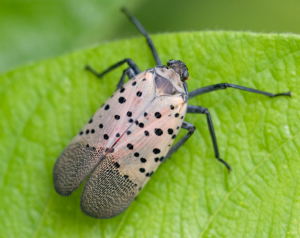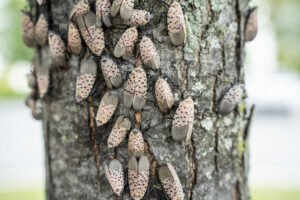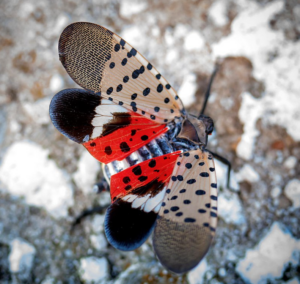Lanternflies
About Lanternflies
Spotted Lanternflies
Spotted Lanternflies have been getting a lot of press and are a real problem. But they are not a problem for lawns. At Teed & Brown, we believe it’s critical that we handle those lawn problems that we can, but to not overstep our mission by attempting to control pests outside of our area of expertise. But let’s dive in a little so you can get a better understanding of what these little guys are all about!

The spotted lanternfly is quickly gaining popularity here in the New England, but not in a positive way.
Originally from China, they were first noticed in Pennsylvania in 2014. Now, these insects are found in 14 states throughout the country including New York, New Jersey and Connecticut.
But what makes them bad?
They are not harmful to humans or pets but they are an invasive species that spread rapidly and are a significant threat to agriculture and ecosystems. They feed on a wide variety of plants, including grapevines, fruit trees, and hardwoods, which can have economic and environmental impact.

A couple of examples what they target:
- Trees: Spotted lanternflies are particularly damaging to trees. They feed on the sap of various tree species, including hardwoods like maple, oak, walnut, and poplar, as well as softwoods like pine and spruce.
- Fruit Trees: They can also damage fruit trees, such as apple, peach, plum, and cherry trees, by piercing the stems and leaves to feed on sap.
- Grapevines: Spotted lanternflies are a significant threat to vineyards, as they feed on grapevines, which can harm grape production and affect the wine industry.
- Ornamental Plants: These insects can infest and damage ornamental plants and shrubs in gardens and landscapes.
- Agricultural Crops: In addition to trees and fruit crops, spotted lanternflies may feed on other agricultural crops, although their primary impact is often on tree fruit production and grapevines.
As mentioned above, these insects feed on the sap of plants by piercing the stems and leaves, which can weaken and damage the plant. The problem isn’t so much with what they eat but with the sugary substance they leave behind called honeydew. The honeydew can attract other pests and promote an abundance of mold growth and fungal infestations.
While they may land on grass or other vegetation, they are not known to be significant pests of grass. So your lawn should be safe (PHEW!)
How to get rid of them?
There are several methods and natural predators that can help control spotted lanternfly populations. Controlling these invasive insects is important to minimize their damage. Here are some factors and methods that can be effective in managing spotted lanternflies:
- Natural Predators: Several native and introduced species of insects, birds, and spiders are known to prey on spotted lanternflies. These natural predators can help keep their populations in check. Some examples of predators include certain parasitic wasps, spiders, praying mantises, and birds like chickens and turkeys.
- Chemical Control: In agricultural and heavily infested areas, chemical insecticides can be used to control spotted lanternflies. It’s essential to follow recommended guidelines and regulations for the safe and effective use of pesticides. Seek guidance from local agricultural extension offices or pest control experts for appropriate chemical control options.
- Traps: Sticky banding traps can be placed on tree trunks to capture spotted lanternflies as they crawl up to feed or lay eggs. These traps can help reduce local populations when used correctly.
- Egg Mass Removal: One of the key strategies is to identify and remove spotted lanternfly egg masses during the winter months when the insects are not active. Scraping off and destroying these egg masses can prevent the next generation from hatching.
- Biological Control: Research is ongoing to explore the use of natural enemies and pathogens that specifically target spotted lanternflies. This may involve introducing or encouraging the proliferation of natural enemies that feed on or parasitize these insects.
- Chemical Treatments for Trees: In areas with valuable trees at risk of damage, systemic insecticides can be applied to protect the trees. These treatments are absorbed by the tree and can deter or kill spotted lanternflies that feed on them.
It’s important to emphasize integrated pest management (IPM) principles, which involve combining various strategies to manage spotted lanternfly populations while minimizing environmental impacts. Additionally, early detection and reporting of infestations play a crucial role in effective management efforts. Local agricultural extension offices and state departments of agriculture often provide guidance and resources for dealing with spotted lanternflies in specific regions.
In summary, they might not be good for the trees and plants but your grass is safe! Stick around to learn more about things that may affect your lawn.

